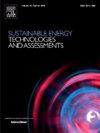SWOT analysis on the transition from Lithium-Ion batteries to Sodium-Ion batteries
IF 7
2区 工程技术
Q1 ENERGY & FUELS
Sustainable Energy Technologies and Assessments
Pub Date : 2025-05-31
DOI:10.1016/j.seta.2025.104371
引用次数: 0
Abstract
The natural and atmospheric circumstances regarding energy resources are experiencing a transformation at the global level due to the exhaustion of the supply of conventional energy resources and climate change. With regards to energy storage systems, lithium-ion batteries (LIBs) have remained the most popular energy storage system technologies because of their high energy density, longer cycle life, and reliability. Nonetheless, the costs and scarcity of lithium as a raw material for REs are unreasonable in the long term. But, new chairs such as sodium-ion batteries (SIBs) are seeing potential benefits over traditional batteries including the availability of Sodium, cost of raw materials, and eco-friendliness. However, there are concerns with SIBs about their less energy density in comparison with LIBs, which needs the invention of expertise. This paper seeks to establish the feasibility of SIBs by analyzing their strengths and weaknesses, opportunities, and threats. Major and minor drawbacks presented in any SIB system are discussed regarding cost performance, safer operation, and environmental gains related to drawbacks such as energy density and cycles per life. Also, important dilemmas regarding LIBs presented in the literature including high efficiency, high power density, and environmentally sound recycling methods are discussed. This study underscores how different conditions may boost SIB performance, commercial feasibility and need for further technical efforts to eliminate existing obstacles so that SIBs can be effectively applied to smarter grids and other renewable energy systems.
锂离子电池向钠离子电池转型的SWOT分析
由于常规能源供应的枯竭和气候变化,有关能源的自然和大气环境在全球一级正在发生变化。在储能系统方面,锂离子电池(LIBs)由于其高能量密度、更长的循环寿命和可靠性,一直是最受欢迎的储能系统技术。尽管如此,从长远来看,锂作为可再生能源原材料的成本和稀缺性是不合理的。但是,像钠离子电池(sib)这样的新椅子比传统电池有潜在的优势,包括钠的可用性、原材料成本和生态友好性。然而,与lib相比,sib的能量密度较低,这需要专业知识的发明。本文试图通过分析sib的优势和劣势、机会和威胁来建立sib的可行性。本文讨论了SIB系统存在的主要和次要缺点,包括成本性能、更安全的操作以及与能量密度和单位寿命循环等缺点相关的环境收益。此外,还讨论了文献中提出的关于lib的重要难题,包括高效率,高功率密度和环保回收方法。这项研究强调了不同的条件如何提高SIB的性能、商业可行性和进一步的技术努力,以消除现有的障碍,以便SIB可以有效地应用于智能电网和其他可再生能源系统。
本文章由计算机程序翻译,如有差异,请以英文原文为准。
求助全文
约1分钟内获得全文
求助全文
来源期刊

Sustainable Energy Technologies and Assessments
Energy-Renewable Energy, Sustainability and the Environment
CiteScore
12.70
自引率
12.50%
发文量
1091
期刊介绍:
Encouraging a transition to a sustainable energy future is imperative for our world. Technologies that enable this shift in various sectors like transportation, heating, and power systems are of utmost importance. Sustainable Energy Technologies and Assessments welcomes papers focusing on a range of aspects and levels of technological advancements in energy generation and utilization. The aim is to reduce the negative environmental impact associated with energy production and consumption, spanning from laboratory experiments to real-world applications in the commercial sector.
 求助内容:
求助内容: 应助结果提醒方式:
应助结果提醒方式:


